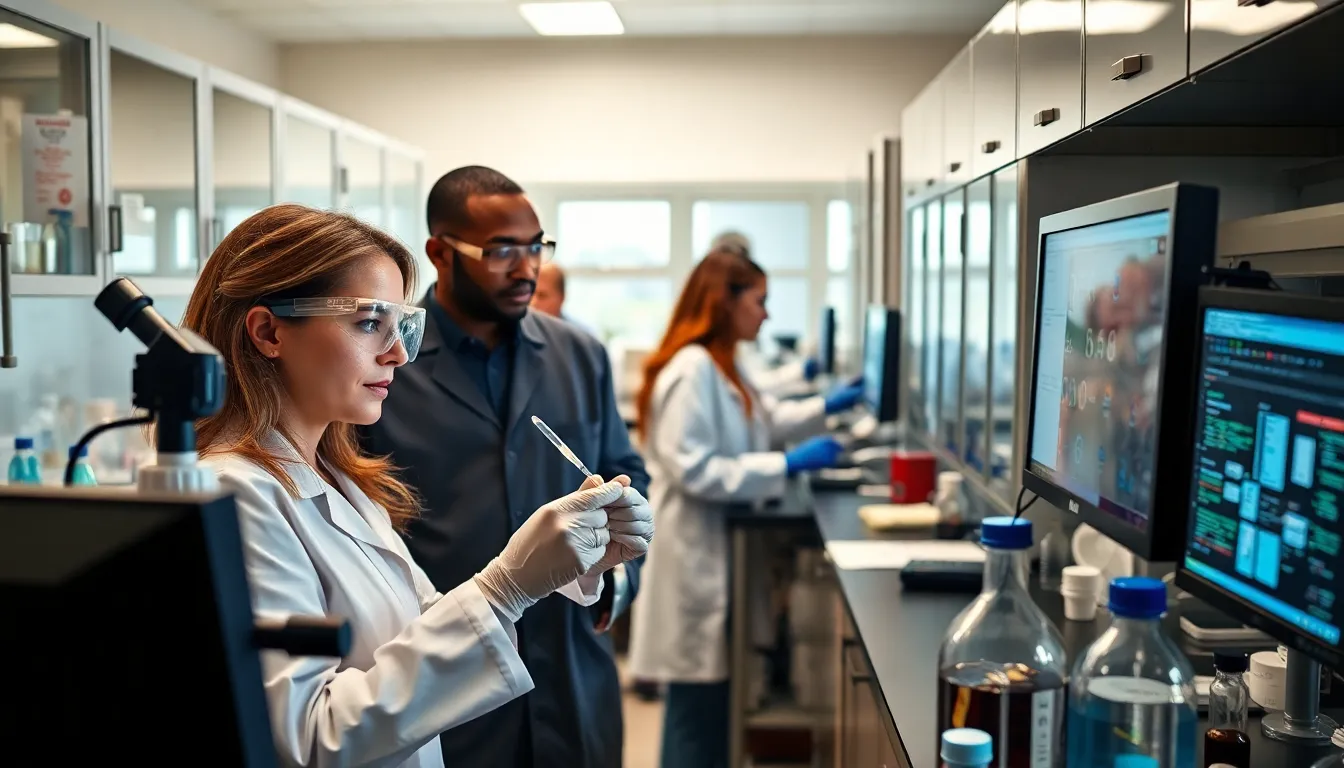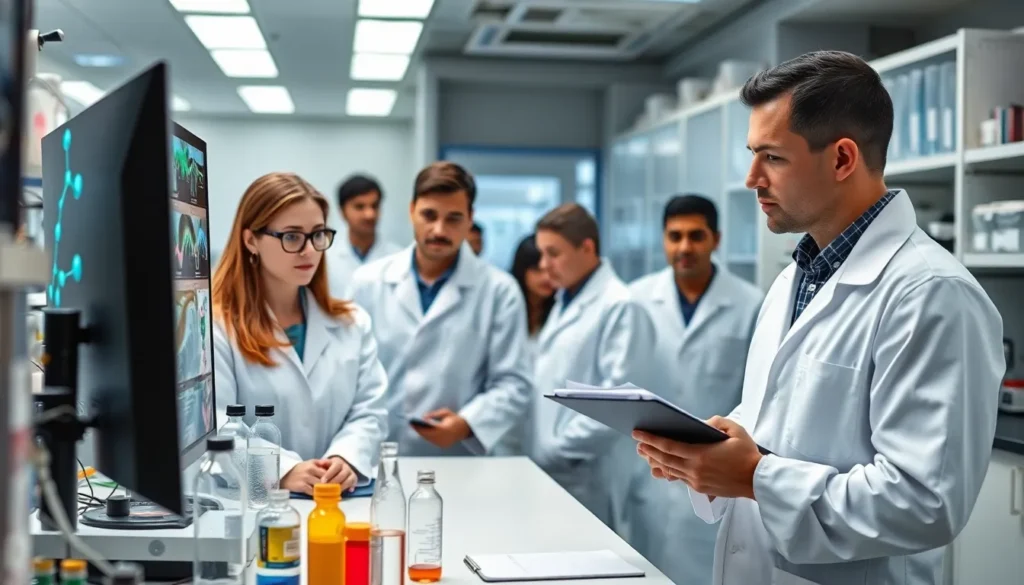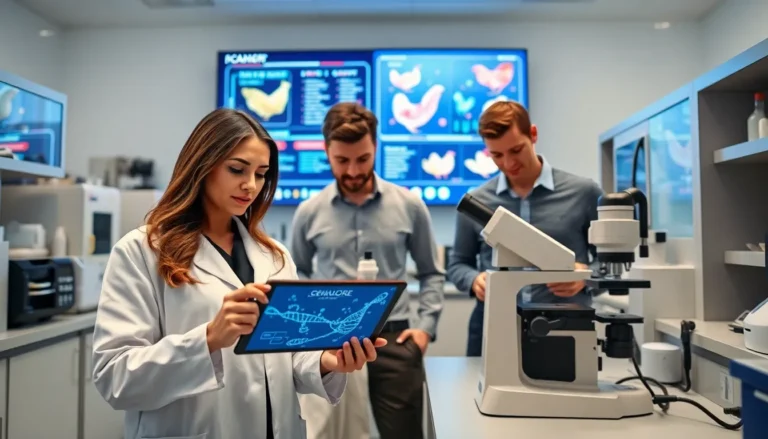In a world where finding a cure for the common cold feels like searching for a unicorn, drug discovery stands as the unsung hero of modern medicine. It’s a complex journey that transforms wild ideas into life-saving treatments. Scientists don’t just wear lab coats; they’re the brave explorers navigating the uncharted waters of biochemistry, armed with pipettes and a sprinkle of hope.
Table of Contents
ToggleOverview of Drug Discovery
Drug discovery represents a complex journey aimed at developing new therapeutic compounds. This process begins with the identification of biological targets associated with diseases. Researchers explore various pathways, looking for potential points of intervention.
Various techniques are employed during the initial stages. High-throughput screening allows scientists to evaluate thousands of compounds quickly. In silico modeling aids in predicting how drug candidates interact with targets, enhancing the efficiency of the selection process.
Once promising candidates are identified, the focus shifts to optimization. Medicinal chemistry plays a crucial role in refining these compounds, enhancing their efficacy and safety profiles. Comprehensive testing ensues, involving both in vitro and in vivo studies to assess the pharmacokinetics and pharmacodynamics of selected candidates.
Advancements in technology have transformed the landscape of drug discovery. Artificial intelligence is increasingly used to analyze data and predict successful candidates. Such innovations accelerate the discovery process, placing emphasis on speed without compromising accuracy.
Collaboration among academic institutions, pharmaceutical companies, and regulatory agencies enriches the drug discovery pipeline. Knowledge sharing fosters innovation and drives the development of novel therapies. This collaborative approach proves vital in overcoming challenges, particularly in the quest for effective treatments against complex diseases.
Ultimately, the goal remains clear: transform scientific discoveries into viable treatments. Adapting to the dynamic landscape of medicine continues to shape the future of drug discovery. Pursuing this path requires resilience and creativity, ensuring progress remains at the forefront of medical advancements.
Stages of Drug Discovery

The drug discovery process involves several critical stages that guide researchers from initial findings to potential therapies. These stages encompass target identification, lead discovery, and preclinical testing.
Target Identification
Target identification marks the first stage in drug discovery. Scientists focus on understanding biological targets linked to diseases, such as proteins or genes. Advanced techniques frequently employed include genomics, proteomics, and bioinformatics. By analyzing these targets, researchers can identify those most likely to yield effective treatments. The goal is to gather comprehensive data on the disease mechanisms. Validating targets through experimental methods assures that they play roles in disease progression, forming a solid foundation for subsequent stages.
Lead Discovery
Lead discovery follows target identification, focusing on identifying compounds that interact effectively with biological targets. High-throughput screening enables researchers to test thousands of compounds rapidly. This process utilizes both natural products and synthetic libraries, ensuring a diverse range of potential leads. Computational methods often support this stage, aiding in molecular docking simulations and structure-activity relationship assessments. Successful candidates from this stage undergo further optimization, enhancing their potential for efficacy and reducing toxicity.
Preclinical Testing
Preclinical testing involves evaluating selected drug candidates in laboratory and animal studies. Safety and efficacy become the primary focus during this stage, which often includes pharmacokinetics and toxicology assessments. Researchers aim to understand how the body processes these compounds and their potential side effects. This testing phase provides critical information necessary for regulatory submissions, setting the stage for clinical trials. Successful preclinical results signal readiness for the next phase of drug development, bridging the gap between lab discoveries and human trials.
Technologies in Drug Discovery
Technologies play a crucial role in enhancing the efficiency and accuracy of drug discovery. Among these, high-throughput screening and computational drug design significantly advance the field.
High-Throughput Screening
High-throughput screening allows researchers to test thousands of compounds rapidly. This technology identifies potential drug candidates by evaluating their interactions with specific biological targets. By automating procedures, scientists save time and resources. Screening assays harness biochemical techniques to assess compound efficacy. Often, researchers leverage robotics alongside advanced detection systems. Data generated from these screenings guide further optimization of promising candidates. Highly effective, this method accelerates the transition from lead discovery to preclinical testing.
Computational Drug Design
Computational drug design utilizes computer algorithms to predict interactions between drugs and biological targets. This method enhances the speed of drug candidate identification, minimizing the need for extensive experimental work. Molecular modeling and simulations allow scientists to visualize protein-ligand interactions. Moreover, researchers depend on structure-based and ligand-based design approaches to optimize drug effectiveness. The integration of artificial intelligence in computational methods improves accuracy in predicting the success of drug candidates. Overall, computational tools streamline the drug discovery process, reducing costs and time leading to viable therapies.
Challenges in Drug Discovery
Drug discovery faces numerous challenges that hinder progress in developing effective treatments. One significant challenge lies in the high failure rates of drug candidates. Approximately 90% of drugs fail in clinical trials, often due to safety concerns or lack of efficacy.
Identifying suitable biological targets presents another hurdle. Researchers must ensure that the targets are relevant to disease mechanisms, which complicates early stages of drug discovery. This complexity increases the resources and time required to conduct research.
Uncertainty in predicting human responses adds to the challenge. Animal models do not always accurately replicate human biology, leading to unexpected outcomes during trials. This discrepancy necessitates additional testing and can delay the approval process.
Regulatory hurdles also pose obstacles. Strict guidelines must be followed before a drug can reach the market. Navigating these regulations requires extensive documentation and compliance, which can strain resources and extend timelines.
Collaboration among stakeholders can be difficult to establish. Pharmaceutical companies, academic institutions, and regulatory agencies must work together effectively. Miscommunication or conflicting priorities can slow down progress and impact innovation.
Financial constraints further complicate drug discovery. Funding for research is often limited, making it essential to prioritize projects strategically. Early-stage startups may struggle to secure necessary capital, impacting their ability to advance new therapies.
Finally, the ethical considerations surrounding drug testing create challenges. Patient safety, informed consent, and equitable access to treatments are paramount. Researchers must balance these ethical concerns with the urgency of bringing new drugs to market.
Addressing these challenges requires creativity, determination, and collaboration within the drug discovery ecosystem.
Future Trends in Drug Discovery
Artificial intelligence continuously reshapes various aspects of drug discovery. This technology streamlines the identification of promising drug candidates, improving research efficiency. Machine learning algorithms analyze vast datasets, uncovering patterns that humans might overlook.
Precision medicine plays a pivotal role in personalized therapies. Tailoring treatments based on individual genetic profiles enhances efficacy, reducing the trial-and-error approach traditionally associated with drug development. Genomic sequencing advancements allow for a deeper understanding of disease mechanisms.
Collaboration between biotech firms and research institutions fosters innovation. Such partnerships accelerate the discovery process, combining expertise and resources. Open-source platforms enable researchers to share data and advancements, promoting transparency and collaboration on a global scale.
Regulatory agencies adapt to these evolving technologies, facilitating faster approvals. Combined efforts between the industry and regulators can lead to streamlined processes, improving patient access to new therapies. Ongoing updates in regulatory guidelines ensure they remain relevant in the changing landscape.
Another trend involves the incorporation of real-world evidence in drug development. Utilizing data from actual patient experiences offers insights into effectiveness and safety outside clinical trials. This approach can better predict how drugs perform across diverse populations.
Finally, addressing mental health through innovative drugs increases focus. Recognizing the growing need for effective treatments in this area drives researchers to explore novel compounds that target psychological disorders. This emphasis reflects a broader shift in societal awareness concerning mental health.
The journey of drug discovery is a testament to human ingenuity and perseverance. As researchers navigate the complexities of identifying biological targets and optimizing drug candidates, their efforts hold the promise of transformative treatments for various diseases.
Advancements in technology and collaborative efforts among key players in the field are paving the way for more efficient and effective drug development. By embracing innovations like artificial intelligence and precision medicine, the landscape of drug discovery is evolving rapidly.
While challenges remain, the commitment to overcoming these obstacles ensures that the quest for new therapies continues, ultimately enhancing patient care and addressing pressing health needs. The future of drug discovery is bright as it adapts to the demands of modern medicine.










